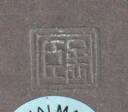Chinese green tea is best enjoyed in antique Yixing teapots.
The Yixing teapots presented below was recovered from
the Desaru (AD. c. 1830) shipwreck.
There are two distinct differences between ordinary pottery and Yixing teapots. The first is the type of clay used. The second: most wares are made by hand and not on a potters wheel. Yixing 'purple' clay is if fact a mixture of the purple soil, the green soil (from the mountains of Yixing) and the red soil. The purple clay arrives from around Lake Tai and the mixture of the three different types of minerals is still a safely guarded secret
Green tea is best enjoyed in antique Yixing teapots made from the precious 'old' purple clay. Three types of Yixing teapots were recovered from the 19th century shipwreck: 'Desaru', each of them featuring a unique potters mark or studio name. Assembled from individual pieces of hand rolled clay, each teapot reflect the skill of its master. Tea lovers all over the world recently re-vitalized the tradition of drinking green tea -in Yixing teapots. The characteristics of the Yixing clay is said to be most suitable due to its porous nature, allowing it to seasoning itself with every brew.
Traditional Yixing teapot clay particles usually range from 0.2 to 0.3 mm in size. The porous nature of this clay is particularly suitable for teapots as the pot absorbs the flavor, smell, and color of the tea that is brewed in it. The repeated use of such teapot makes it better every time. Many old Chinese people still carry with them their favorite teapot whenever they travel
10.5cm high Yixing teapot from the Desaru (1830) shipwreck
9.5cm high Yixing teapot from
the Desaru (1830) shipwreck
6.5cm high Yixing teapot from
the Desaru (1830) shipwreck
All Yixing teapots recovered from the Desaru shipwreck, tentatively dated to 1830, are marked in the base with a potters marks. This mark will sometimes show the name of the factory and include a Chinese poem, most frequently associated with mountains, spring water and the like. The marks shown below represents all marks and stamps found on the Desaru shipwreck site.

Mark 1

Mark 2
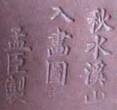
Mark 3
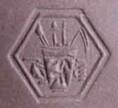
Mark 4

Mark 5
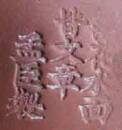
Mark 6
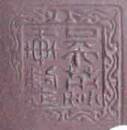
Mark 7
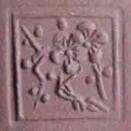
Mark 8
Mark 9
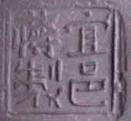
Mark 10
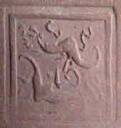
Mark 11
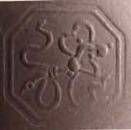
Mark 12
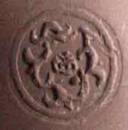
Mark 13.
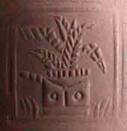
Mark 14
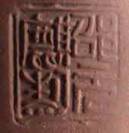
Mark 15
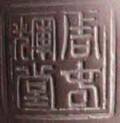
Mark 16
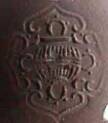
Mark 17
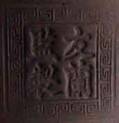
Mark 18

Mark 19

Mark 20
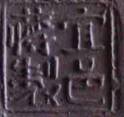
Mark 21
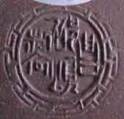
Mark 22

Mark 23
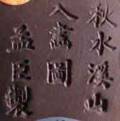
Mark 24

Mark 25
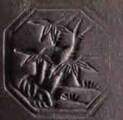
Mark 26
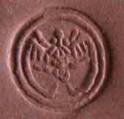
Mark 27

Mark 28
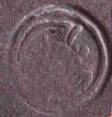
Mark 29
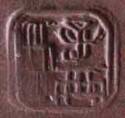
Mark 30
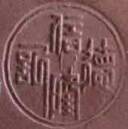
Mark 31
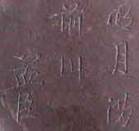
Mark 32
Mark 33
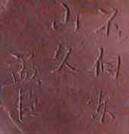
Mark 34
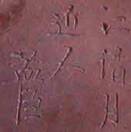
Mark 35
To view Yixing Teapots for Sale, go to: Artifacts for sale
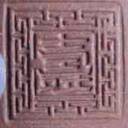
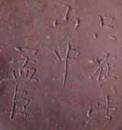
Green tea and teapots made in Yixing; the Yixing teapots are the most suitable for enjoying Chinese green tea. Made by hand, these tea pots was made for the famous green tea growing in the higher ranges of mountains in China. Green tea is nowadays also considered healthy by most researchers. Green tea, antique Chinese teapots and teapots made from purple clay are the most famous of all teapots.
Interesting web pages:
THE ONLY PLACE WHERE YOU CAN BE SURE TO BUY GENUINE ANTIQUES
Nanhai Marine Archaeology Sdn. Bhd. was incorporated on the recommendation of the Malaysian authorities. This was done in order to formalize and to expand on the company’s researcher’s extensive knowledge of Asia’s ceramic developments and maritime trade.
The company’s researchers have been engaged in the search for historical shipwrecks for more than two decades and another decade researching maritime trade. Most of this work is concentrated to the South China Sea, a virtual highway for ancient shipping linking China to India, the Middle East and Southeast Asia in an extensive maritime trade system. This ancient trade started sometime around the 4th century and lasted well into the 19th century.
Following a successful shipwreck discovery, the company obtain a government permit to excavate the wreckage, and then carry out detailed marine archaeological procedures in recovering the artifacts, mapping the ship's remains and securing other data for future research. After each concluded project and following conservation of recovered artifacts, we search for and pinpoint ruined kiln sites and compare its wasters with the recovered ceramics until we are satisfied we located the place in which the shipwreck pottery was made centuries earlier.
As such we have precisely located a kiln sites in Sisatchanalai, northern Thailand in which our Royal Nanhai and the Nanyang shipwreck celadon ware was made around AD. 1380-1460. (See videos on: http://www.ming-wrecks.com/photopage.html ) Other kilns was located in Sukhothai where production wasters matched the fish and flower plates found on the Turiang and the Longquan shipwreck. These unique underglaze decorated wares was made at those exact kilns 600 years earlier! Our latest shipwreck cargo; The Wanli Shipwreck, of Chinese blue and white porcelain, was likewise pinpointed to the Guangyinge kiln site in Jingdezhen, China. (See video on: http://www.ming-wrecks.com/photopage.html )
Our arrangement with the Malaysian authorities is such that we finance all operations and train young Malaysian nationals (on our initiative) in maritime archaeology and related research. After giving all unique and single artifacts and thirty percent of all recovered items to the National Museum (and assisting with exhibitions of artifacts from each project) we are allowed to sell our portion of the recovery to finance future projects. The findings from ongoing research and the compilation of reports, books and catalogues are available on these pages as well as on a separate Internet site: http://www.maritimeasia.ws
Due to the unquestionable authenticity and precisely dated shipwreck pottery, many International Museums now display our shipwreck pieces as reference material.
The artifacts sold on this website are therefore legally and properly excavated and can be supplied with an export permit from the Department of Museum in Malaysia should this be required. This unique working arrangement makes us one of the few Internet sellers that sell from own excavation and deliver a meaningful Certificate of Authenticity with every artifact issued with a serial number.
So, if you are interested to purchase some of our Antique porcelain, old time pottery or other shipwreck artifacts from the Song dynasty, Ming porcelain or Chinese blue and white porcelain or the famous Yixing teapots, you can rest assured that every piece is excavated through proper archaeology by our own staff. We do not sell anything that is not excavated by ourselves or properly recorded and researched before offered for sale so every piece comes with the “Best possible provenance”
WE ENCOURAGE YOU TO EMAIL OUR PRINCIPAL RESEARCHER; Sten Sjostrand SHOULD YOU HAVE ANY QUESTIONS ABOUT YOUR POSSIBLE PURCHASE
 | ||||
CLICK ON BELOW IMAGES TO VIEW OUR SALES PAGES
 | ||||
Nanhai Marine Archeology Sdn. Bhd.
CLICK ON ABOVE IMAGES TO VIEW OUR SALES PAGES.
Few of the teapots had shells and other marine growth decoration the pots
Mark 36













